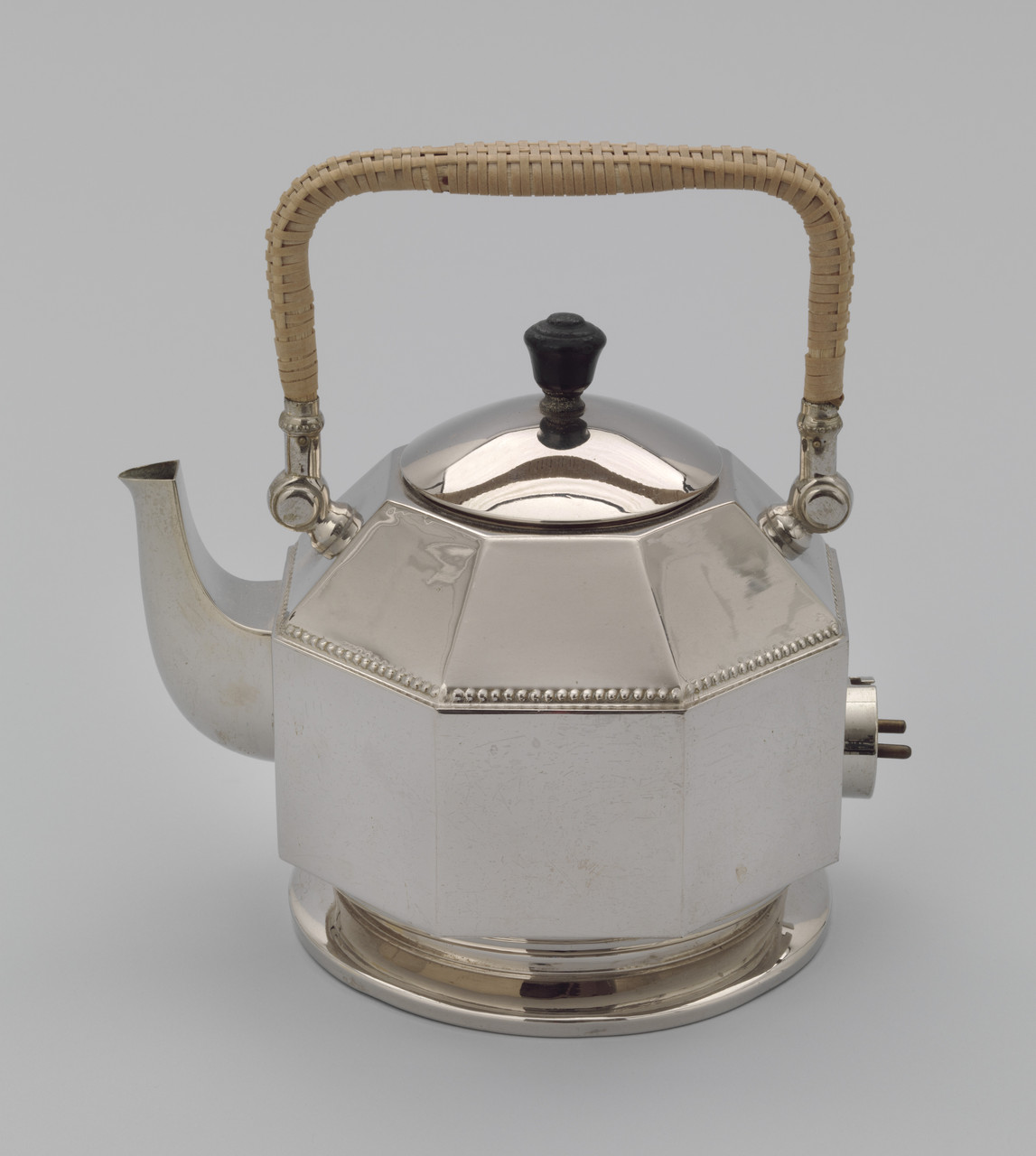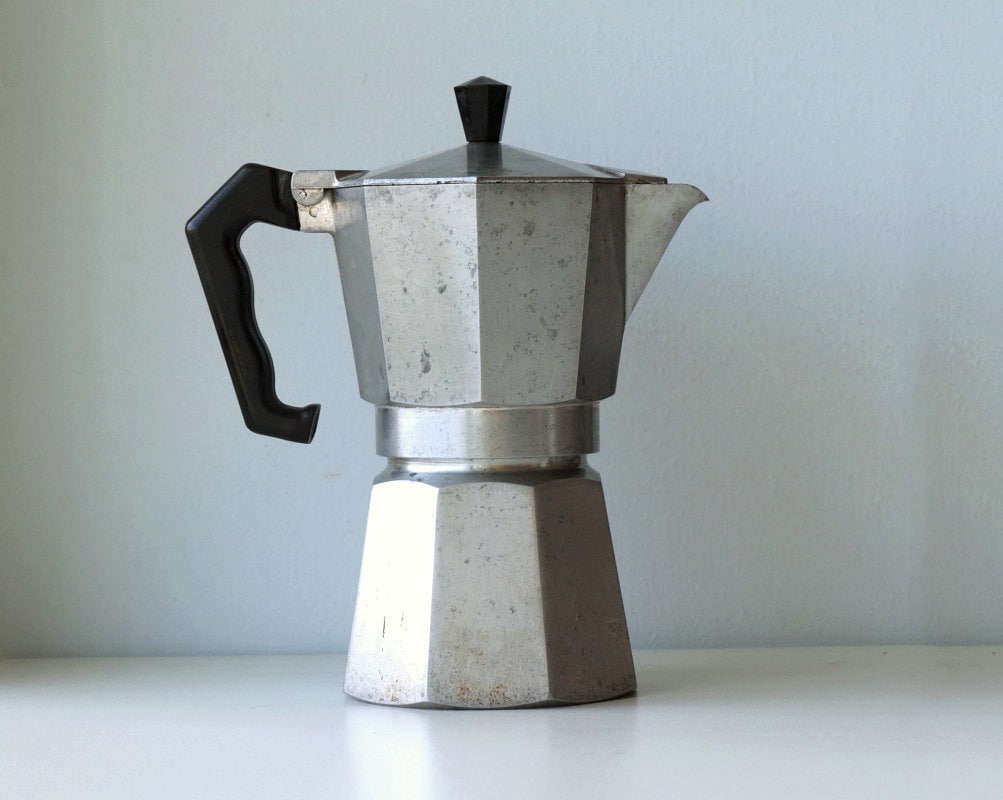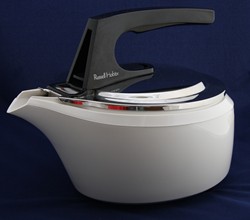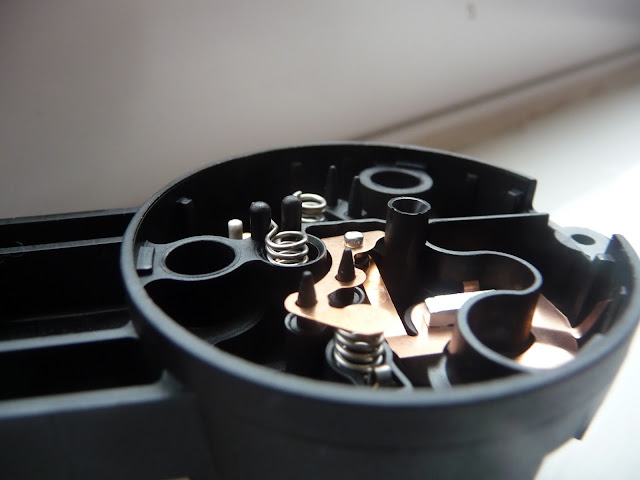Kettle Project : The Market Teardown History Aesthetics Process Concepts Costing Induction
CAD on Fusion 360
Outward progress this week is hard to communicate, as my main focus has been to recreate my current kettle on CAD. After a successful social media campaign, I have caved in and decided to give Autodesk Fusion 360 a go, which is useful as I can run it on my Mac. This gives me a steep learning curve, and so re-creation is an essential part of learning about the kettle parts and also getting used to the software. Some of the data may be useful in the design stages at a later date.
My first starting part is the main body of the Strix R7 controller, which is very complex, but gets me used to all the solid modelling components; mainly the easy stuff like sketching, dimensioning and extruding.
Good Design? The current market
My received conceptions of 'good design', in an academic sense is that products should be a combination of a total aesthetic and a total functional whole, that is, that they should be functionally brilliant, and aesthetically impactful; and that these two wholes should combine into something that clearly communicates it's intention to the market.
Given these lofty, philosophical criteria, I find myself admiring strict, logical and functional designs.
One such example is the Ritter Fontana 5:
"...produced only in Germany. A clear design in Bauhaus style with no extraneous decorations, featuring rock-solid processing & technical perfection. Multiple award winner, partially made by hand, by ritter of Bavaria (established 1905)."
Well in line with the aspirational, neo-modernist line I have generally trodden, this design appears to be a very well executed product, all helvetica, geometric forms and clear functional details. It takes a step beyond mainstream kettles by including temperature selection, and therefore probably a digital controller (although not necessarily a proprietary one). To add to that, it is made in Germany, the knockout punch for any Dieter Rams fetishist, and putting it squarely in the camp of the no-nonscence 'good form' crew, along with Miele, Bosch, LAMY, Volkswagen and Braun.
The price? £140, which is semi-understandable given that isn't made in China, and is made from 'Heat resistant Acrylic' instead of the usual Polypropylene, but I wonder if it is too highly specified, it is certainly not a mass-market proposition.
Slightly closer to the ground, although not too much so, is the Bosch 'City', which arrives at £59, and features another confident but neutral exterior. This is made in China and that is probably where the majority of the cost savings have been found, assuming both are priced with reasonable honesty. Looks familiar?
There are apparently not many ways of designing a 'rational' kettle from these german examples. What we can learn is that we touch black, smooth surfaces, and don't touch the hot metallic or glossy surfaces, and that the handle must be at a slight angle for ease of pouring. We must also ignore draft angles in the initial designs, preferring straight edges, and then uncomfortably accept them in the later stages, as evidenced by the Bosch model's subtly curved sides.
A starkly different option, pure in a different manner, is the Muji Electric Kettle, designed by Naoto Fukasawa, costing £60. A dramatic blend of traditionalism and pure minimalism, it's careful, soft forms compared to the jaunty steel of the german models teach us a lot about the differences between contemporary minimalism and functionalism. This is a very good example of total functional and aesthetic unity in a product, as the minimalism expressed is a functional reality, having only 500ml capacity and a power rating of 1430W. Such figures are laughable compared to my £5, 1.7l, 2200W kettle, this is a very good example of what misfit's architecture has termed 'voluntarily poverty'. Muji are experts at getting people to buy into the idea of having less.
The concept of voluntary poverty automatically separates and stigmatises the involuntarily poor because they have no choice but to aspire to the voluntarily poor. To have the choice is an aspiration in itself.
Climbing further down into the mass-market, we find ourselves at a model I believe to be a solid example of a reasonable middle-ground product.
Taking a blend of both approaches at an accessible price of £30, this phillips model is both functional and minimal. I also think that the base is a clever and subtle solution, probably taking advantage of the seamless nature of a controller like the relatively new Strix KeAi series.
One interesting angle to come at with regards to 'good design' is to look at semi-commerical products.
Simple, unassuming and robust, the Burco KTL02 achieves the goals that the aforementioned consumer kettles merely 'represent'. Products designed for commercial use tend to be heavier duty and less showy, which should please the stoics, however because they are bought by managers as long-term investments for their staff to suffer, they lack the creature comforts that modern consumers expect, in this case the 360 base and flat bottomed interior. Innovation tends not to be the realm of the commercial sector, as the primary concerns are cost-effectiveness, durability, and legal safety.
Looking over to Japan, BIC Camera have this Dretec Model at the bottom of their offering. Impressively designed as base-spec models go, at around £10 this is a sensible and basic kettle, but without the ugliness that we come to expect at this end of the spectrum. Can we put it down to the 'zen' nature of the Japanese public? I'm not so sure, but it is an example of how good, common sense design has no reason not to exist at all levels in the market.
Alessi MG32
Hegel said we should learn from our adversaries however, so I have extended a line of inquiry out of my comfortable grounds of sensible, minimal, functional design and into the realms of postmodern excitement by purchasing a broken Alessi MG32. At £30 I could have bought 6 working kettles!
Needless to say, it does have an extreme Aesthetic presence in a way I haven't seen since I bought the Tizio, the MG32 has a way of filling the room with it's attitude. This must be a sign, however subjective, of it's actual aesthetic content: the kettle is both space-age and weirdly nostalgic. It is also big: it's base is a 30cm circle, which fills the room aesthetically and physically; which confirms my suspicion that statement pieces fill and own the room they are set in, dictating a style. However flowery this sounds, a significant achievement of any product is that it can shout out a style intelligible by anyone in a way more subversive than words can achieve, and I understand that now more than ever.
It is also explicit in it's communication of manufacturing quality: the finish on the stainless steel is exquisite, the chrome steel is both extremely well polished and noticeably flat and consistent. Alessi are known masters of steel processing and finishing, and it is clear from the mirror finish; no dents, no scuffs and clear edge transitions, even though this is a well-used product. It is this subtle quality that people are buying when they buy Alessi; not just postmodern expression, and this, I have found, is undoubted.
What it has missed however, is functional independence. Alessi have missed the opportunity to provide a technical alternative to the hegemony of Strix and Otter kettle controls, and have therefore missed the lofty heights of the Apple MacBook and the Artemide Tizio. Without genuine technical difference, the 'quality' argument is severely diluted.
Obviously, Alessi would rather sell the virgin Michael Graves kettle, but they have found themselves yielding to the consensus of the electric kettle market. The price works out somewhat: a standard Alessi kettle costs around £80, and for the extra components, it deserves a price of £150 for the aforementioned quality of construction; but it has failed to reach the lofty heights of Dyson cleaners or Vitsoe furnishings, which justify their price with a full portfolio of genuine functional and manufacturing achievements.
It's red indicator light covers have not stood the test of time.
Which is a shame, because the kettle has legitimately taught me something about the power of a full, aesthetically complete design.
Good Design
Given these observations, I seek to make a slightly over-confident definition of Product Design aesthetics. Although not attempting to make a global, John Dewey-esque treatise on aesthetics, my back-on-an-envelope description is as follows:
"There is no pre-established harmony that guarantees that what satisfies one set of organs will fulfil that of all the other structures and needs that have a part in the experience, so as to bring it to completion as a complex of all elements. All we can say is that in the absence of disturbing contexts, such as production of objects for a maximum of private profit, a balance tends to be struck that objects will be satisfactory - "useful" in the strict sense - to the self as a whole, even though some specific efficiency be sacrificed in the process" - John Dewey, Art as Experience
All we can wish functionally is that the performance of the components and their visual appearance work together to communicate and enable good use; this is basic utility and can be seen whenever a switch looks like a switch and turns red once it's on. A positive and essential basic achievement of good design.
The final stage is the aesthetic and functional unity of the product as a whole. This can be seen, for example in the iPhone, where both the interface and the visual design are developed together to reach something totally whole and understandable.
In this study, however compromised, we can see that the Muji kettle is a very complete expression of form and function. Whatever technical drawbacks it may have, all of it's aspects have been borne of the same, consistent philosophy, and therefore any criticism is a criticism of the philosophy itself and not of the product. We see this also in the Burco commercial kettle; design that has not yielded to the fashionable sways of whatever generation we are in, but presents a clearly-communicated and sensible option. The Alessi and the Bosch fail in this regard, they are desperate to find higher aesthetic meaning, without the balls to realise this with functional independence.
The conclusion then, it that products are at their best when they are wholly independent and consistent in their philosophy. This is basically how we have come to find our icons: the Tizio, the Mac, the Unite d'Habitation. Having said that, functional independence comes at an economic cost, something that half-way options like the strix-based MG32, android-based phones and Sapper's windows-based ThinkPad have discovered to their demise. All come from good intention but cannot be considered totally designed products.
If we are to design a cheap, useful and emancipatory product, the demands of common economics dictate that we should either invest to steal the whole market, as Apple have done, or if looking to deliver at a low price-point, communicate with honesty about the generic nature of the final product.
This is why cheap design struggles; it is between the rock and the hard place of genuine cost-saving and finace-driven market differentiation. It is the options at the bottom-end of the market that I am most keen to examine; do we sell minimalist-modernism as a 'new' idea, or can we make a statement based on low-cost itself?
























